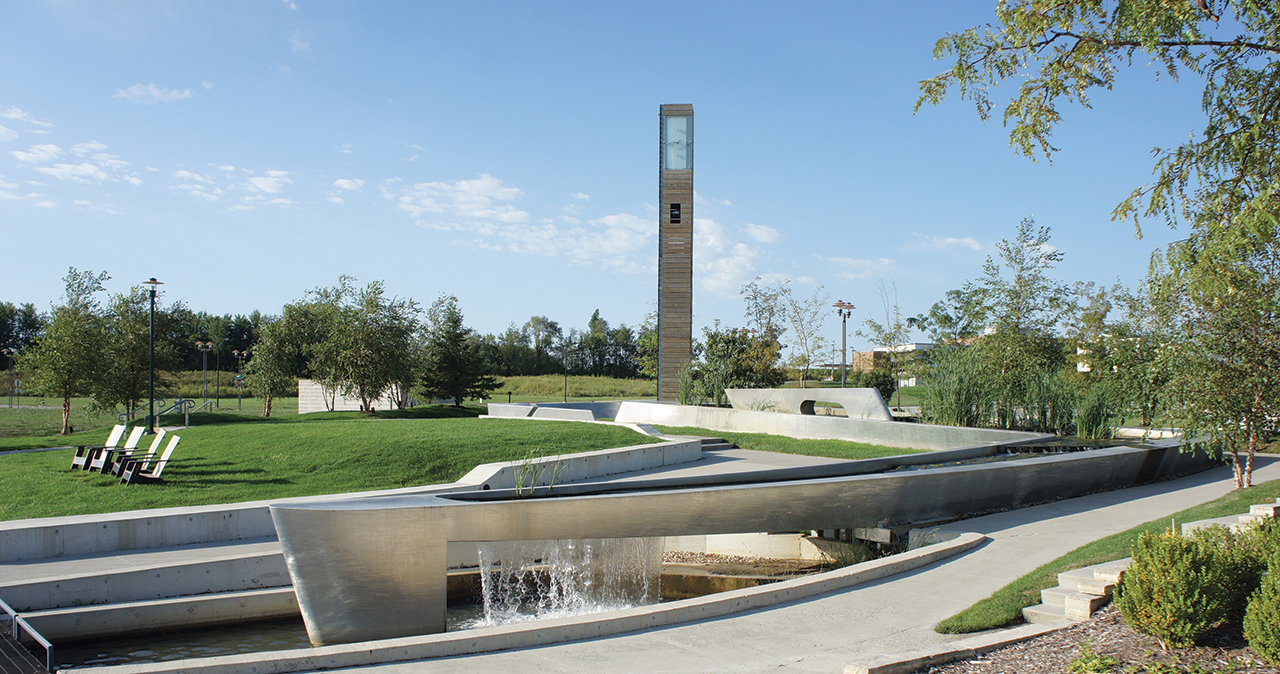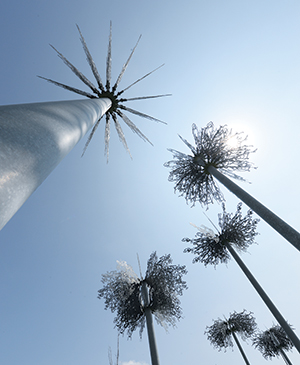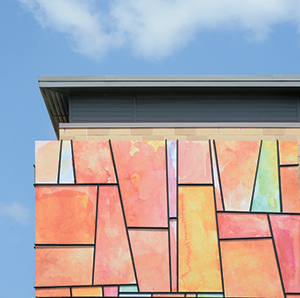Above: Portions of an old county bridge are incorporated in Dennis Reynolds’ artful and appropriate entryway to the Bridge District, a recently developed downtown neighborhood along the east side of the Des Moines River.
Writer: Laurel Lund
Photographer: Duane Tinkey

It takes a village to create a village. And when it comes to exemplary urban design and creating a sense of place, Dennis Reynolds is the virtual mayor.
“I have a passion for placemaking,” says the founder of Des Moines’ award-winning Reynolds Urban Design firm. “I love creating a sustainable, integrated environment—whether it’s a neighborhood, a building or a site—where a diverse group of people can gather.”
And he does it masterfully, from Des Moines to Dubai, say those who know him. Reynolds “is the ideal urban planner,” says Kris Saddoris, vice president of development for Hubbell Realty. “He connects the landscape, the environment and the intended community and ties them together with an iconic work of public art that people can relate to. He sees the big picture.”
That’s evident in Reynolds’ work on Hubbell’s new Bridge District downtown. A light-industrial/warehouse area along the east side of the Des Moines River (just north of the Women of Achievement Bridge and south of I-235) was converted into an integrated, mixed-unit residential neighborhood with compact and efficient landscapes, streetscapes and parking space.
The Bridge District differs from today’s typical suburban townhome development where parking and wide streets dominate the community’s character, or lack thereof. Reynolds has interwoven contemporary architecture with lush green space that includes yards and a central park area.
Reynolds has “the ability to come up with fresh, meaningful ideas that suit the project at hand,” says local graphic artist and architectural photographer Jake Niederhauser, who worked with Reynolds on a project for the Village of Ponderosa in West Des Moines. “His ability to consider both the big picture—entire developments, neighborhoods and cities—and the smallest design decisions, such as how benches are constructed, is what really sets him apart from the crowd. His experience as both an artist and a designer gives him a well-rounded view of the projects he takes on.”
At the Bridge District, a public installation Reynolds created forms the park’s centerpiece. The massive bridge sculpture, interspersed with repurposed steel, is anchored by two rustic railings from a Boone bridge. “I had to speak with over a dozen county road supervisors to help find the right bridge,” Reynolds recalls.
A sculptural canopy of white steel and Lexan (a thick polycarbonate used for bulletproof shields) shimmers above the bridge in waves of colors that represent those of the nearby river. It also represents the bluegills that swim beneath the waves. A ribbon of soft light surrounding the canopy gives it an ethereal glow after sunset.
The sculpture also includes Ipe wood benches atop decking made from heavy oak timbers similar to those from the Boone bridge. “It’s old technology wrapped in new,” Reynolds says.
That is Reynolds’ niche in the urban planning world: weaving old and new technologies and turning old memories into new ones through public works of art that reflect a sense of place. And he does it by creating beauty from objects not typically seen as beautiful, such as wheels from old cars and agricultural equipment from Iowa farms; manhole covers from local city spaces; and memorabilia from an old mill town.
Reynolds’ expertise has evolved over his three-plus decades of urban planning. After earning a bachelor’s degree in fine arts from Wheaton College and a master’s degree in landscape architecture from Kansas State University, the Kansas City native launched his career in the Windy City at Harland Bartholomew and Associates, the firm that created the master plan for Des Moines in 1927. Reynolds, now 62, subsequently was recruited to join nationally recognized architectural firms NBBJ and HOK, where he became a principal in its Kansas City office, overseeing projects in China and Taiwan and winning a gold medal for his design of the Nanjing Olympic Park in China. He moved to Des Moines in 2006 to work as the development design director for Ladco Development, settling here with Charlotte, his wife of 36 years, before opening his own firm.
“Throughout my career, I have learned that public art is about creating a space to come together and celebrate a community,” Reynolds says.
Saddoris says that concept is evident in Reynolds’ work: “He knows how to pull all of the aspects of a place together to create a neighborhood, a community, a sense of place. He’s a visionary.”
Reynolds’ Projects in Greater Des Moines

Reynolds’ project “Shimmer,” the gateway to the Village of Ponderosa in West Des Moines, received the 2014 Central States’ American Society of Landscape Architects (ASLA) Honor award for Built Environment and the 2012 Award of Excellence for the Iowa chapter of ASLA.
Inspired by Grant Wood’s paintings, including “Stone City, Iowa,” and “The Stone of Wall 1,” the centerpiece of this mixed-use urban development serves as a public plaza to bring people together after dining at nearby restaurants or following corporate and community events.
The canoe-shaped sculpture of raw aluminum, which is both cost-effective and durable, carries water to and from the recently depth-plumbed lake. On its circular journey, water drops down a series of small weirs before falling into the lake.
“Seating surrounding the sustainable ecosystem is intended to feel organic, like an iceberg broken apart in pieces,” Reynolds says.
Photograph courtesy of the artist

The Clive-based project “Leap of Faith” was a collaboration between Reynolds and acclaimed artist Jesse Small to create the entrance to Mercy’s Wellness Campus. The grove of abstract, lace-like trees of galvanized steel symbolizes the Tree of Life as well as the qualities of health, growth and abundance.
The project is named for Faith Garnaas, the wife of campus developer Jon Garnaas. Faith was uncertain about the original design concept. Finally she gave it the green light, declaring, “Let’s just take a leap of faith and do it.”

The random geometric pattern and vibrant color palette of “Colorways” serve as an illuminated beacon at the entrance to the Village of Ponderosa, where Reynolds served as head urban designer.
The mosaic-like pattern of the translucent Teflon piece boasts a Craftsman-style influence. The colors of the design, inspired by Iowa’s historical agricultural development trends, are reminiscent of a rural sunset.
To create the outsize piece, Reynolds painted a large watercolor, then Des Moines graphic artist and architectural photographer Jake Niederhauser digitally screened it onto the Teflon fabric before installation.

In August, Reynolds broke ground on “In the Loop,” a project that borders the east side of Metro Waste Authority’s headquarters in the East Village. Using manhole covers and repurposed steel parts from factories, farms and construction implements, this interactive destination is designed to reflect Metro Waste’s mission of recycling. Note the abacus-like structures that can be moved about the sculpture to express the sense of place each visitor feels.











